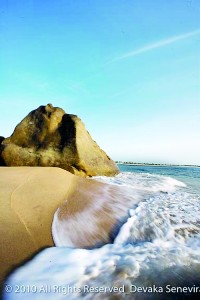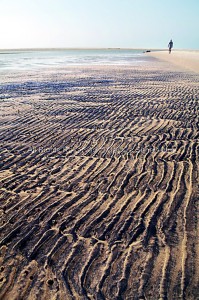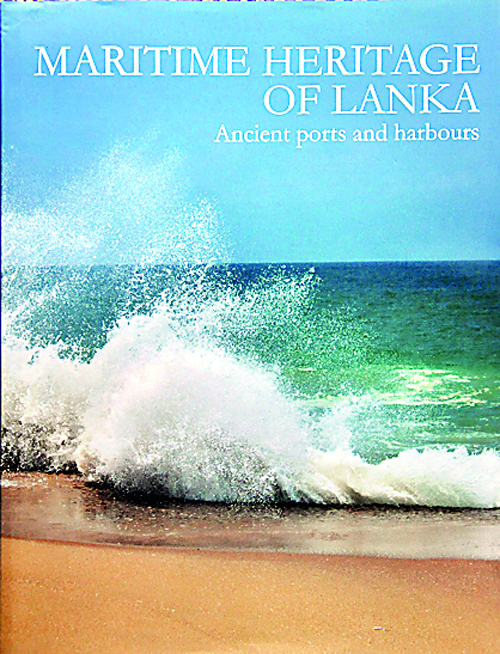Sea ways to Tambapanni
View(s):“W e islanders are all children of the sea, travellers since ancient times, unafraid of outward migration and the search for new horizons….”(Sarala Fernando. Editor)
It is long since I sifted through pages of articles crafted by specialists and non specialists, an amalgam of history, archaeology, nautical traditions and technology, brilliant photographic images of ancient material, culture and nature, historical and modern cartography, ethnography, international trade and contacts among a wide range of searching topics covered in a single book. This also is the

Pottuvil
authentic multiple histories of the Sri Lankan mosaic. A land known by many a name to the World Systems located to the east and west of this island, its history is essentially a story of trans-oceanic connectivity. It is a story how this island came to evolve its unique personality due to the convergence of multiple streams of people, cultures, languages, religions, ethnicities and technologies. The historical saga of Sri Lanka, an island situated in a pivotal position in the Indian Ocean rim, could not be inscribed otherwise in the annals of history and most certainly not without the story of the sea – a story of nurtured reciprocity as one of the most valued “ports of call” in antiquity. The title, Maritime Heritage of Lanka: Ancient Ports and Harbours, is indeed a reflection of that historical reality.
While this book, according to its editor, is presented as a continuation or accompaniment to the valued publication Sri Lanka and the Silk Road of the Sea (1990), in many ways it moves beyond the parameters set by its predecessor. In a collection of twenty one articles accompanied by a user friendly bibliography, maps and “come alive” images the product is a rich corpus unfolding the multi faceted character of transoceanic Sri Lanka.
The editor charters the road map of maritime history through several chapters covering a broad area on the one hand while narrowing down to specific themes on the other. What caught my eye is the interplay between the macro and micro in the topics selected for chapters. The book anchors itself in the most obvious cultural and ecological niche – ports and harbours as vantage portals of connectivity and then interlocks it with subjects that may be placed under broad categories viz. international connections and trade; points of convergence; technology; maritime archaeology and material remains; littoral resources and fauna – all contextualized within time, space, culture and environment.

Wold horses in Mannar
The opening chapters on the Geostrategic Environment and Foreign Contacts with Sri Lanka, sets the stage for the historic chain of oceanic and hinterland connectivity, while the two follow up articles on Literary References: Ports of Historical and Spiritual Contacts and Historic Anuradhapura and the Ports that served its interests, are informative but could have been less parochial and romantic and drawn evidence from sound stratified material evidence. The Chapter on Cartography of Sri Lanka, presents an excellent collection of maps from Ptolemy (C.50 AC) to Knox (1681) providing insights to changing scales, details and the significance of this island in the eyes of foreigners. In the study of Sri Lankan history (or elsewhere for that matter), we are yet to ascertain the symbolic and real value of cartographic representations chartering the spatial factor and resources in the grammar of politics.
Perhaps the most significant contributions in this volume, in my view, are found in the chapters on the archaeology of ancient ports and their material culture, nautical technology and endangered eco systems. Several scientific land and marine based archaeological investigations were undertaken in the North and the East of the island in the post conflict period enabling a better understanding of the maritime heritage of Sri Lanka. New light on the Early Historic Settlement at Kantarodai (a site located beyond the votive stupa site at this village), is one such article that

Adam’s bridge, Talaimannar
records the most recent scientific excavations undertaken after 1970 at this important site in the Jaffna peninsula. The significance of Kantarodai needs be recognized by situating it at par with the Citadel of Anuradhapura, Mantai(Mahatirtha) and Akurugoda at Tissamaharama(Mahagrama) where all these four urban centres are reference type sites and repositories of ancient material culture providing stratified evidence on transoceanic connectivity with the Indian Ocean Rim, the Mediterranean, South East Asia and the Far East. I am equally gratified to note the article Arippu and its Surroundings featuring the now submerged coastal site of Kudiramalai (Horse Point mapped even by Ptolemy), which may have an antiquity over Mantai. This region, originally noted by Knox and later R.L. Brohier (1931), is dotted with Early Iron Age (e.g. Pomparippu) and Early Historic sites and may have been subject to tectonic activities and oceanic submergence causing these sites to remain hidden in history. This article needs to be read along with The Search for Pearls and Chanks: a Dwindling Resource, so as to recognize the significance of a chain of littoral sites and their primary involvement with this luxury item that made the Gulf of Mannar an area of attraction to seafaring merchants and predatory invaders alike.
The archaeological narrative of seafaring activities in the south east is featured in several well written informative articles. The south-east sea board and its littoral represent a series of small ports of call in a “looping trade net work”. The Ancient sea-port at Kirinda in Ruhuna and The Ancient Wreck at Godawaya represents the dedicated investigations by teams of young land and marine archaeologists. It also signals the value of small port sites that had a stake in the international trade along with large port sites during the Historic Period.
Three important, but less studied segments in Sri Lanka’s oceanic long distance trade are nautical technology, exchange mediums and trading communities. The first is elaborated in an excellent depiction of vessel types and nautical technology in The Lost Ships of Sri Lanka while the second aspect is documented in Numismatic Evidence of Pre Colonial Foreign Trade in Sri Lanka and The Silver Wreck on the Basses Reef. The third aspect is represented by a single article, namely, Muslim Contribution to Maritime Trade in Sri Lanka. The absence of South Indian merchants, merchant guilds and Hindu religious sites at strategic port and inland sites is a serious omission and needs to be addressed in a reprint or in an accompanying volume to this book. The study of all three areas is an imperative for a proper understanding of logistical dynamics and movement of traded items,the cash vortex, primary players and stake holders in the perpetuation of long distance and short circuit trade associated with this island.
 The book ends on a sober and sensitive theme where the editor inscribes that the “…publication responds to the call for a sustainable environment, the urgent need to find solutions to the threat of extinction facing the large mammals, elephants and whales and the humble turtle and chanks, whose existence …has been documented since ancient times” not to mention their value as prized objects in the luxury long distance trade. This is all about appreciating natural and cultural heritage within the context of a sustainable environment and sustainable development strategies. A study of the flora, both in its natural habitat in the littoral and as a traded item may have completed the picture in this section.
The book ends on a sober and sensitive theme where the editor inscribes that the “…publication responds to the call for a sustainable environment, the urgent need to find solutions to the threat of extinction facing the large mammals, elephants and whales and the humble turtle and chanks, whose existence …has been documented since ancient times” not to mention their value as prized objects in the luxury long distance trade. This is all about appreciating natural and cultural heritage within the context of a sustainable environment and sustainable development strategies. A study of the flora, both in its natural habitat in the littoral and as a traded item may have completed the picture in this section.
It is quite obvious that this volume presenting samples of a multiple range of topics to the reader cannot carry and cover every segment associated with the maritime heritage of this country. Yet, one wishes such publications will take cognizance on the geo-archaeology of coastal Sri Lanka that had a direct impact on marine resources and the formation of port sites. Secondly, the inland marine trade and resources that went in to form a critical symbiosis connecting inland Sri Lanka to world systems through oceanic gateways surrounding her.
Sarala Fernando needs to be congratulated for translating her experience and vision of a professional diplomat unfolding the historic dynamics that placed Sri Lanka on the map of connectivity to the world. Maritime Heritage of Lanka is a book that needs to be read and preserved and is a worthy effort supported by the National Trust of Sri Lanka and the Central Cultural Fund and graciously sponsored by the National Development Bank PLC.
(The reviewer is Professor of Archaeology, University of Peradeniya). The book is available at the National Trust Office, PGIAR, Bauddhaloka Mawatha, Colombo 7
| Book facts
Maritime Heritage of Lanka: Ancient Ports and Harbours |


